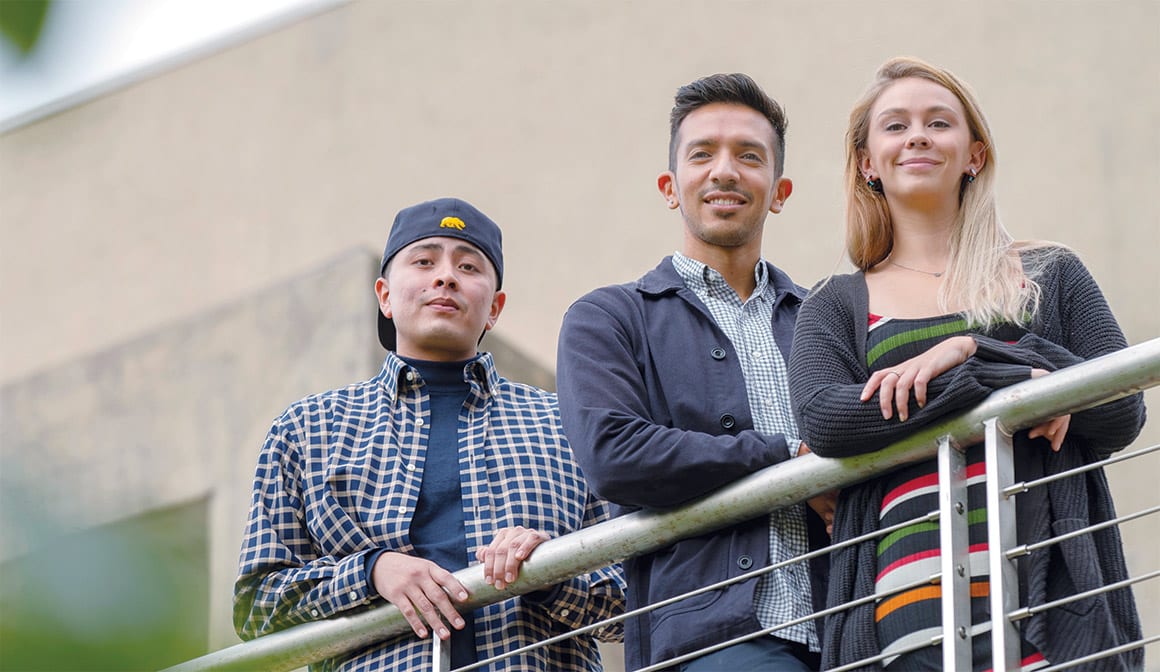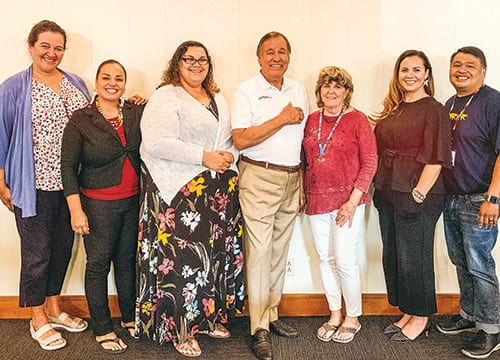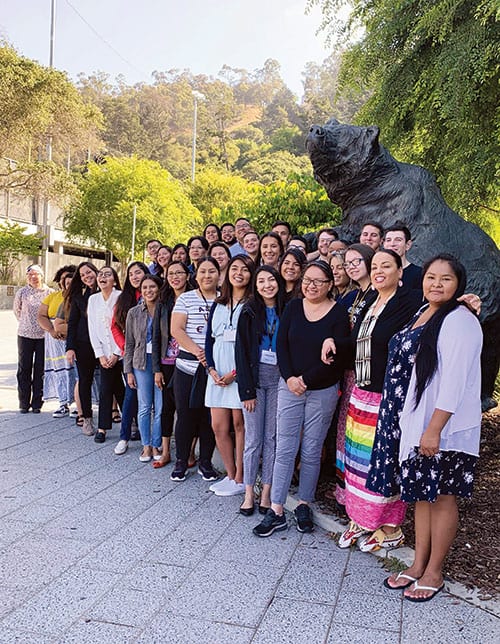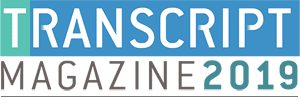
Native Americans gain a meaningful foothold at Berkeley Law thanks to students, faculty, and staff.
By Andrew Cohen
Given how quickly Dallas Lopez ’21 became one of Berkeley Law’s most committed student leaders, it seems hard to fathom that he nearly went elsewhere.
A member of the Gila River Indian Community near Phoenix, Lopez wanted to attend a law school in California “where I could be around other Native law students and learn about federal Indian law.” Frankly, he says, he didn’t see that as a viable option at Berkeley.
There was scant Native representation among Berkeley Law’s otherwise robust population of students of color. While the school once boasted the nation’s foremost expert on federal Indian law and policy, Professor Philip Frickey, a void had existed since his death in 2010.
During the summer of 2018, Lopez attended the Pre-Law Summer Institute (PLSI) for American Indians and Alaska Natives, a two-month program that trains participants for the rigors of law school. Studying with Native students and professors, Lopez felt “at home.” Seeking that same feeling of connection, he had committed to UC Irvine largely because of Professor Seth Davis, who described his work with tribes and federal Indian law during Lopez’s visit to the school.
But timing, as they say, is everything. Berkeley Law participated in PLSI for the first time that summer, allowing Assistant Dean of Admissions and Financial Aid Kristin Theis-Alvarez and Assistant Director of Admissions Joseph Lindsay to meet with students there.
“They shared how Berkeley Law was interested in having more of a Native American community and that Professor Davis was going to be moving there,” Lopez recalls. “I was shocked and unsure of what to do. They shared a vision for a growing community at Berkeley Law, and when they were finished, I eagerly wanted to be a part of it.”
Before joining that new community, however, Lopez learned that he would need to help build it—and fast.
Reviving and recruiting
In chatting with Theis-Alvarez and Lindsay, Lopez asked if he could be part of the law school’s Native American Law Students Association (NALSA).
“They both looked at each other and shared that there wasn’t currently a NALSA chapter at Berkeley,” Lopez says. “Everyone at PLSI had been talking about their NALSA programs and the community that was going to be there for them. Entering Berkeley Law, I knew that I wasn’t going to have that community, but I wanted to make sure we could create it and that students coming after us would have it.”
During the first week of class—searching for the other Native 1Ls that Theis-Alvarez and Lindsay told him had enrolled—Lopez introduced himself to pretty much everyone he saw and shared that he was a member of the Gila River Indian Community. Bit by bit, he met the people who joined his fervent push to reestablish Berkeley’s NALSA chapter.
“By the end of the first week, we had found each other,” Lopez says of Ashleigh Lussenden, Emiliano Aguirre, Zach Meeker, and Naya Coard. “By the second week, Mr. Lindsay shared that if we wanted to start the organization, we’d have to move fast. We met in Café Zeb, quickly assigned roles, and applied to be a law school organization. We had no idea what we were doing, but we were so excited.”
Lopez reached out to PLSI classmates for advice, and received PowerPoints, documents, and many helpful insights. The students worked at a fever pitch with Davis to assemble an executive board, made up of many of the founding members along with Lindsay DeRight Goldasich ’21 and Gia Jung ’21, to have Berkeley’s chapter reactivated for the 2018- 19 school year. They met the deadline—barely.

“It took a lot of time and a lot of trial and error, but we learned to navigate the institution and were given an incredible amount of support along the way,” says Lussenden, a member of the Cherokee Nation of Oklahoma. “We also created a real community within the law school that allowed us to grow and share together over the course of our first year and gain a lot of visibility as strong and diverse Native people.”
Berkeley NALSA now promotes the success of Native students, creates awareness around Native issues, promotes networking with Native alumni, and fosters a culture of unity, cooperation, and respect. Activities include lectures, conferences, and mentorship initiatives aimed at boosting academic and legal prosperity for members, a supportive community of peers, and deeper engagement with federal Indian law.
Coard describes the organization as “my safe space” after leaving Long Island, New York, where she grew up as a member of the Shinnecock Indian Nation.
Pipeline to Law Initiative
It might seem like the surge in Berkeley Law’s Native American student population—and the wide-ranging fruit it has born in 2019—happened overnight. Truth be told, it was years in the making.
Theis-Alvarez had spent the past five years developing and refining the Pipeline to Law Initiative with other colleagues. Serving Native college sophomores, juniors, seniors, graduate students, and students preparing for law school, the program offers test prep support, networking, mentorship, information about law-school application criteria and funding options—and the opportunity to hear from former and current Native law students.
The roots of Theis-Alvarez’s efforts go even further back; since 2008, she has been a faculty member at Graduate Horizons, a pre-graduate summer intensive program for Native Americans. Last summer, Lindsay attended the program for Berkeley Law in Appleton, Wisconsin.
The Pipeline to Law Initiative, held previously at other campuses, came to Berkeley Law for the first time this year in June. The school welcomed 36 participants representing 21 tribal nations from around the country who heard from Dean Erwin Chemerinsky, attended trainings and workshops, attended mock classes that included a federal Indian law session with Davis, and received guidance on applying to and thriving in law school.
Participants were also welcomed by activist Corrina Gould of the Confederated Villages of Lisjan/Ohlone, and got a surprise visit from 1964 Olympic gold medalist Billy Mills (Oglala Lakota).

“This university was founded on Indian land, and as an institution we need to invite the community into it,” TheisAlvarez says. “We have to make sure we’re reaching out in a positive and respectful way, and also giving back.”
While Coard had no direct experience with Pipeline to Law, her sister Aiyana traveled to Berkeley from the University of North Carolina-Greensboro to take part.
“She recently got interested in applying to law school,” Coard explains. “She’s big into social justice, women’s empowerment, and other issues having to do with the black and brown communities. For her, the chance to do this and network with faculty members was terrific.”
Forging an identity
Berkeley Law Admissions also co-created, with PLSI and the American Indian Law Center, the first conference to train people who work with Native undergrads on guiding them through the application process. In February, on the Isleta Pueblo in New Mexico, Theis-Alvarez and Lindsay were among a group that counseled pre-law advisors and others from tribal colleges and universities, Native student development offices, and nonprofits who are positioned to help Native students interested in law school.
“We can’t go everywhere, but there’s no shortage of passionate leaders and educators in Indian Country who can reach many more students than we ever could,” Theis-Alvarez says. “Connecting with these advisors is critical, as is building trusting relationships.”
Less than 1 percent of all LSAT takers identify as Native American and it’s roughly the same percentage for law school applicants, which means there are very few Native lawyers and fewer judges.
“However, there’s strong interest in using the law as a tool for improving the lives of tribal people,” Theis-Alvarez says. “We have to design opportunities and programs that bridge the gap.”
This summer, she traveled to the University of Oregon’s Many Nations Longhouse to share that message with attendees of the Pacific Coast Association of Pre-Law Advisors’ annual conference. Berkeley Law was back at PLSI last summer, and the Native pre-law advisors conference will take place again in February.
Meanwhile, reviving NALSA at Berkeley led to the chapter lobbying for—and winning—the privilege of hosting the 28th National NALSA Moot Court Competition (February 21-23). Davis is writing the mock case, giving participants a chance to dive into a legal issue within federal Indian law.
“Some of us were able to go to the Federal Bar Association’s Indian Law Conference in Albuquerque in March,” Lopez says. They did so with the help of an alumni donor who, coincidentally, had expressed interest in supporting NALSA.
“With help from Professor Davis and Dean Chemerinsky, it all somehow got willed together and our presentation to host moot court won out,” Lopez adds. “I’m hearing that this will be the biggest moot court ever.”
NALSA’s leaders encourage Berkeley Law grads to attend, volunteer at, or help sponsor the moot court event via the Berkeley Law website. They also aim to expand the group’s alumni network and database. Students and alumni who identify as indigenous can email nalsa.ucberkeley@gmail.com for more information about the group and its activities.
Building bridges, shattering myths
Amid the increase in Native American student representation and campus programming, Aguirre hopes to help create an enduring bridge—not just for other Native students who come to Berkeley Law, but also for Native children everywhere.
“I grew up on the Navajo reservation, where a lot of children aren’t introduced to finance, economics, STEM, or law,” he says. “There are so many fascinating career paths within each of these areas. I think getting kids interested in law can be accomplished by working with local schools, after-school programs, and organizations that interact with youth. I’ve seen STEM-related workshops in local communities … and strongly believe the same can be done for law.”
Bolstered by joining PLSI, reviving NALSA, and hosting both the Pipeline to Law Initiative and national moot court competition, there is a growing sense that Berkeley Law will become a destination for Native American students.
“We want this to be a place tribal nations feel good about sending students,” Theis-Alvarez says. “That means we have to make lasting commitments, and listen carefully to what students and communities need from us.”
Seven Native students are in this year’s 1L class, and that incoming talent could be a game-changer. Berkeley NALSA hopes to reconnect with alumni, develop a scholarship program, and entrench the law school as a beacon for prospective Native attorneys. Simply spreading the word that such a community exists is a huge priority.
While earning her Ph.D. in Neuroscience at Stony Brook University, Lussenden recalls, “My ties to my Native identity were buried underneath all of my other daily activities, and I assumed that was how the entire world worked. Once I got to Berkeley and had the chance to explore that side of my identity and how it would interact with my professional persona, I relished the opportunity.”
Seeing new students “coming in excited about what we’re doing and wanting to get involved validated all the work we did last year to create this space,” she adds. “They really give me hope that NALSA at Berkeley Law will just continue to grow, educate, and influence.”
Spreading the word
That work involves strengthening the school’s internal Native community and increasing its visibility to all students.
“The most challenging aspect is the continued realization of how little people know about Native issues and how much ground we have to cover to make sure those issues are fully recognized,” Lussenden says. “The student body has been very receptive to listening and showing up for us, but it is not without its challenges.”
Lopez, who in addition to being NALSA president is editor-in-chief of the Berkeley La Raza Law Journal and an executive board member of the school’s Coalition for Diversity, relishes the work ahead. A law clerk last summer for his tribe in Sacaton, Arizona, he grew up around other Native Americans not knowing that the law was an option.
“When I decided to pursue law, my entire tribe got excited,” says Lopez. “We have a large tribe … 22,000 people, but we have relatively few lawyers, so it was a big deal. But it was a hard, isolating experience because there was no one to guide me along the way.”
Now, Lopez and his fellow NALSA leaders are pushing to ensure that other Native Americans have a feasible, well-supported path to law school—and a true haven once they arrive.
“None of the top-tier law schools are creating new space for Native law study and Native scholarship,” he says. “Berkeley can do that. We’re making the case for it.”
And making it well.
John Hickey contributed to this story.



